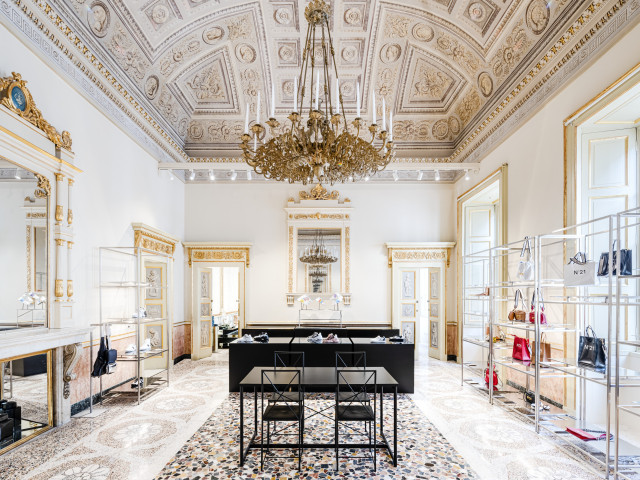MILAN — The global pandemic that started spreading in Europe and the U.S. during the fall 2020 sales campaign last February and March deeply impacted the finely tuned machine of the fashion industry. Among the changes COVID-19 accelerated, the impossibility of traveling and the consequent digitalization of the buying process stand out as among the most disruptive and transformative. This is true for fashion houses, but also, and probably most dramatically, for multibrand showrooms that had to rethink their operations and strategies, embracing technology to reinvent the sales experience.
A year after the pandemic started shaking the world, WWD reached out to key Milan showrooms to learn what has changed so far and what lessons they learned.
Brand Identity Is Key
“During the digital sales campaigns, it strongly emerged that the brands performing well are those with a strong identity and a precise image,” said Riccardo Grassi, founder of the namesake Milan showroom, distributing a wide range of labels, spanning from MSGM, Erdem and Carolina Herrera to emerging brands, including Vivetta and Act No.1. “Coherence is king and this is true for both contemporary and luxury labels.”
Giacomo Piazza, cofounder and fashion director of 247, a showroom headquartered in Milan’s Brera district — which works with 54 global brands, including 3.1 Phillip Lim, Cecilie Bahnsen, Dion Lee, GmbH, Proenza Schouler and Sunnei, to cite a few — stressed the importance for brands to boost their X factor. “Now more than ever, to be appealing, brands have to feel and look special,” he said.

Related Gallery
Fall 2021 Trend: Earth Tones
Unique design needs to meet a special communication strategy, according to Massimo Bonini, founder of the namesake showroom, the leader in Milan in the accessories segment with brands such as Sophia Webster, Castaner, No.21 and Haus of Honey. “The quality of the project is extremely relevant nowadays,” he said. “The brands that can succeed in this complicated scenario are those that are very coherent, very impactful at a design and communication level.”
Nanushka, fall 2021 Courtesy of Nanushka
Price Matters
“The price point remains absolutely fundamental,” said Piazza, highlighting how some contemporary brands are performing extremely well also with digital sales campaigns. For example, he cited Nanushka as a successful case. “If they had increased prices by 20 percent, they would never have had the same success,” Piazza said. According to Bonini, digital actually helped to boost the business of brands with accessible prices. “However, at the same time, buyers and retailers are happy to invest also in brands with a very high price point, but in that case, products must be absolutely unique and exclusive.”
Earlier Is Better
“Pre-collections are more and more important, 80 percent of the sales are made during the pre-fall and resort seasons,” said Grassi, highlighting that stores are pushing to get products earlier. “In an ideal world, I think that brands should do two collections a year with different deliveries,” he said, adding that for example the spring lineups should be presented and sold between June and July, instead of September.
“We are pushing many of our brands to do only two lineups a year to be presented during the pre-collection seasons,” said Piazza, who also thinks that the market moment should be differentiated by the official presentation. “I think that sales should be anticipated and brands should present during fashion weeks what has been actually sold reaching final consumers,” he said.
Physical Is Not Dead
“Buyers cannot wait to return to travel and physically see the collections,” said Bonini, referring especially to those buying luxury products with high prices. Bonini added that already for the spring 2021 season, retailers and buyers did everything possible to travel to Milan to buy the collections in the showroom. “Along with Italians, we had a lot of Russian buyers, but also the executives of the most important European stores,” he said. Grassi couldn’t agree more. “Even if this past season, 70 percent of the orders have been made digitally, everybody expressed the desire to return to the experience of the physical showroom,” he underscored.
Piazza thinks that things will evolve in the near future. “The digital tools will stay with us and will actually be implemented,” he said. “We will return to do the showroom in Paris, but we are studying new, more updated and exciting formats.”
A style from Haus of Honey collection. Courtesy of Haus of Honey
North America Is Resilient
Although it has been severely hit by the pandemic, the North American market is showing strong signs of resilience, according to Grassi and Bonini.
“American buyers and retailers felt very active and positive this past market season,” Grassi said. “They have bought collections that will hit the stores in five or six months, when 80 percent of the population is expected to be vaccinated. I think the positive rebound effect will be incredible.”
North America is a key market as well for Bonini, which operates a showroom in New York. “We got very good results in the United States and we think that America will remain our second biggest market, after Europe, in the future.”
Source: Read Full Article


